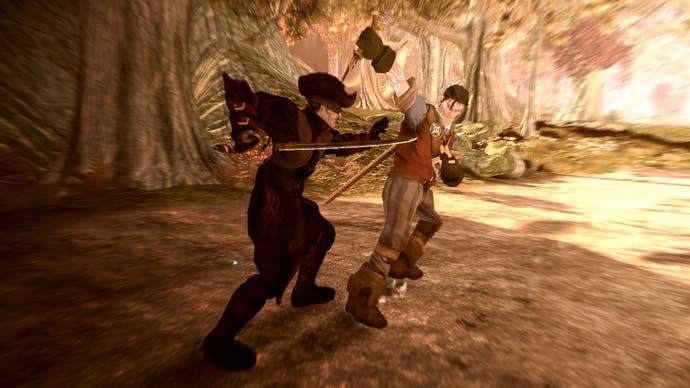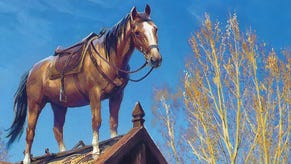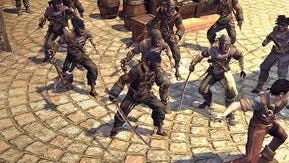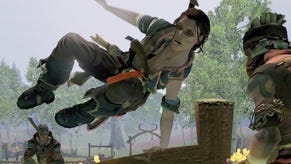The Art of Fable 2
Lionhead's artists down brushes for a pre-release chat.
Fable 2 is so close, you can almost taste it. After what seemed like endless delays and date slips, the first game won the hearts of many with its charming presentation, surprisingly open world and the ability to be a bisexual bigamist who sacrificed innocent villagers. At least that's how we played it.
So with a far more controlled development schedule and a vastly more powerful console at its disposal, it's no wonder we're a bit excited about Fable 2. For the team behind it, though, it's been a remarkable challenge and a labour of love, and a few weeks ago we got to sit down with two of the men most directly responsible for the game's unique look - technical art director Ian Lovett, and lead concept artist Mike McCarthy - for a frank chat about art, technology and sleepless nights.
And this may also be about the only Fable interview you read which doesn't even mention the bloody dog, so savour it.
We looked back at what was good about Fable - that's the first thing you do. I always felt that Fable was about these incredible, lush, green environments, and about really quirky characters. Not necessarily the most beautifully realised characters - but there was lots of personality there. It had a certain atmosphere to it that we wanted to recreate.
Once we had our pillars, our visual pillars, then we sat down and talked about how we wanted to re-imagine it. We did a horribly wanky thing, actually, which is that we came up with a visual mission statement. Although it's awful, nasty, business yuck, what it helped us do was to concentrate our thinking into how we'd really describe it. Secondly, it helped us to sell it up the chain. You know, Microsoft weren't just going to rock up with a fat chequebook of X million, or whatever, and say "hey guys, go ahead, we're going to take a punt on you despite the fact that you were years late with Fable - do another one for us!"
What we decided was that we wanted Fable 2 to be like Fable, but done by Ridley Scott. That was our mission statement. The idea behind that is that Microsoft understand Ridley Scott, they understand that this means that we wanted to mature the franchise a little bit. Not losing its charm, but basically trying to grow it up ever so slightly. I think that fits in very well with the jump from Xbox to 360. It's not that it's a change in audience - it's just a new layer of sophistication.
Oh, and we made the feet smaller.

Yeah, we made the feet and the hands smaller. We brought in the proportions of everything, so it isn't quite as cartoony - a slight movement towards reality. We do know that whenever you do that with a successful product, you've got to be aware that this is the stuff that people like about it, so you've got to keep that in mind.
Look what happened to the Diablo guys!
Yeah, exactly. You've got to keep what's good about it - but we did want it to be darker, and moodier.
It's interesting, you know. Fable made Microsoft a lot of money, and with that comes a tremendous amount of responsibility, because it's "yeah, brilliant, a Franchise! Grab that bad boy!" They come back to the same team who made it, because hopefully there's a good chance that they'll do a reasonable job of it.
Oh, we had good production this time! [Laughs] Somebody cracking the whip!
After about every sixteen minutes, you'd be asked, "Is it done? Is that done? Is it done yet? Now? Is it done?"
The scariest thing was, though, that it's a tremendous amount of faith on Microsoft's behalf. We decided that we weren't going to use a middleware engine. We looked at Unreal - and it's an amazing engine, don't get me wrong. We've got nothing against it. But it wasn't what we needed for Fable, so we said, let's go and develop another engine.
Of course, that means that for the first two years of development, you're not going to see anything. All you're going to see is concepts, a couple of tests... The amount of faith which that takes when you've got a franchise which, in Microsoft's eyes, is number two only to Halo, and the money that goes with that. That's a tremendous punt to take on a bunch of people.

So, we had to spend quite a bit of time selling the fact that this was going to look the way we said it would, that we were going to be able to re-imagine this in an appropriate way for the 360 - bringing all of these disparate elements in, and doing it in a shorter time, with a bigger team and all the challenges that come with that. It was really challenging - but we had a brilliant team.
I think that in the 3D part, actually doing the characters and doing the environments and stuff, all we could do really was ask the teams to build stuff how they thought it should look in the game. They built it, textured it and lit it - and then there was a huge transition between "right, that's how we want it to look" and "can we get the engine to make it look that way?"
The only reason we've done it quicker this time is because we cut the slack and the waste. We whiteboxed everything before we built it this time. In Fable 1, we were dicking around with the design all the way through - we didn't know how big a house had to be until we'd already made some models! This time we used sketch art and whiteboxed out things, so we knew that when we built things, they were roughly the right size.
We didn't cut anything out to finish the game in a shorter timeframe. We were just a lot more efficient.
















